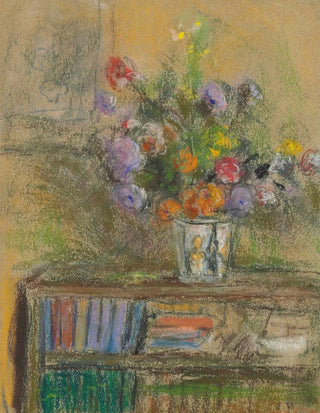Art print | Still life with a vase of flowers - Édouard Vuillard


View from behind

Frame (optional)
The floral vase still life by Édouard Vuillard is a piece that transcends the simple frame of painting to immerse us in a universe where everyday beauty blends with striking visual poetry. This artwork, emblematic of the Nabi movement, invites viewers to contemplate the delicacy of the flowers while questioning the depth of the emotions they can evoke. Through vibrant colors and harmonious composition, Vuillard manages to capture the very essence of nature, transforming a fleeting moment into a timeless experience. This piece, while a faithful representation of reality, also evokes an intimate atmosphere, conducive to daydreaming.
Style and uniqueness of the work
Vuillard's style is distinguished by his unique approach to color and light. In this art print, pastel shades intertwine with brighter touches, creating a contrast that draws the eye and awakens the senses. The flowers, although frozen on the canvas, seem to vibrate with a life of their own, as if they are about to bloom. The artist's technique, favoring delicate brushstrokes and subtle application of colors, lends the overall a mood of softness and serenity. Every detail, from the vase to the petals, is carefully crafted, demonstrating a deep respect for natural beauty. Through this art print, Vuillard does not merely depict objects; he offers us an aesthetic experience where the gaze is happily lost.
The artist and his influence
Édouard Vuillard, a major figure of the Nabi movement, established himself as an innovator in the art world at the end of the 19th century. Influenced by symbolist currents and contemporary artists such as Paul Gauguin, he developed a style that combines intimacy and modernity. Vuillard has always sought to express human emotions through scenes of everyday life, and his floral vase still life is a perfect example. His work has had a significant impact on subsequent generations of artists, inspiring movements such as Impressionism and Fauvism. By reinterpreting the themes

Matte finish

View from behind

Frame (optional)
The floral vase still life by Édouard Vuillard is a piece that transcends the simple frame of painting to immerse us in a universe where everyday beauty blends with striking visual poetry. This artwork, emblematic of the Nabi movement, invites viewers to contemplate the delicacy of the flowers while questioning the depth of the emotions they can evoke. Through vibrant colors and harmonious composition, Vuillard manages to capture the very essence of nature, transforming a fleeting moment into a timeless experience. This piece, while a faithful representation of reality, also evokes an intimate atmosphere, conducive to daydreaming.
Style and uniqueness of the work
Vuillard's style is distinguished by his unique approach to color and light. In this art print, pastel shades intertwine with brighter touches, creating a contrast that draws the eye and awakens the senses. The flowers, although frozen on the canvas, seem to vibrate with a life of their own, as if they are about to bloom. The artist's technique, favoring delicate brushstrokes and subtle application of colors, lends the overall a mood of softness and serenity. Every detail, from the vase to the petals, is carefully crafted, demonstrating a deep respect for natural beauty. Through this art print, Vuillard does not merely depict objects; he offers us an aesthetic experience where the gaze is happily lost.
The artist and his influence
Édouard Vuillard, a major figure of the Nabi movement, established himself as an innovator in the art world at the end of the 19th century. Influenced by symbolist currents and contemporary artists such as Paul Gauguin, he developed a style that combines intimacy and modernity. Vuillard has always sought to express human emotions through scenes of everyday life, and his floral vase still life is a perfect example. His work has had a significant impact on subsequent generations of artists, inspiring movements such as Impressionism and Fauvism. By reinterpreting the themes






